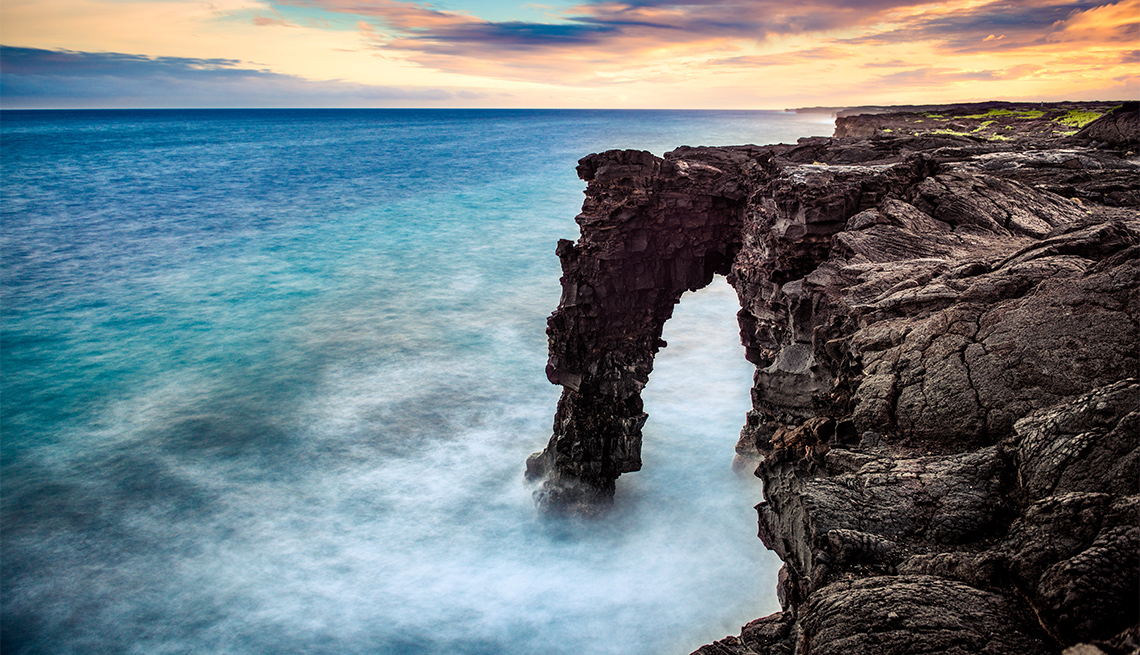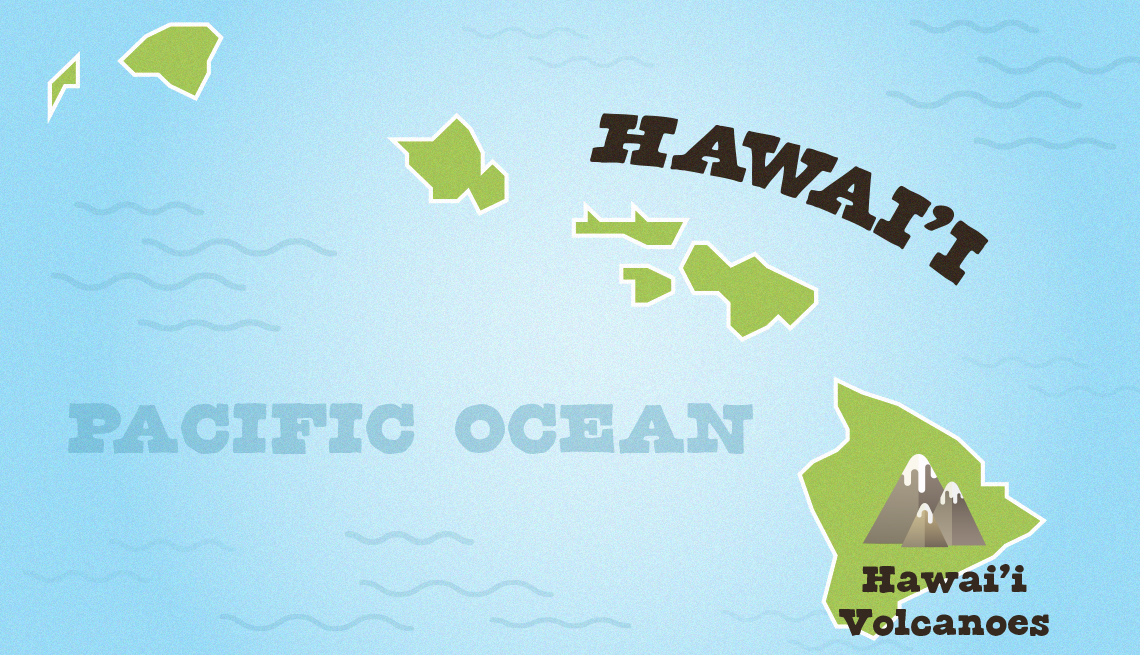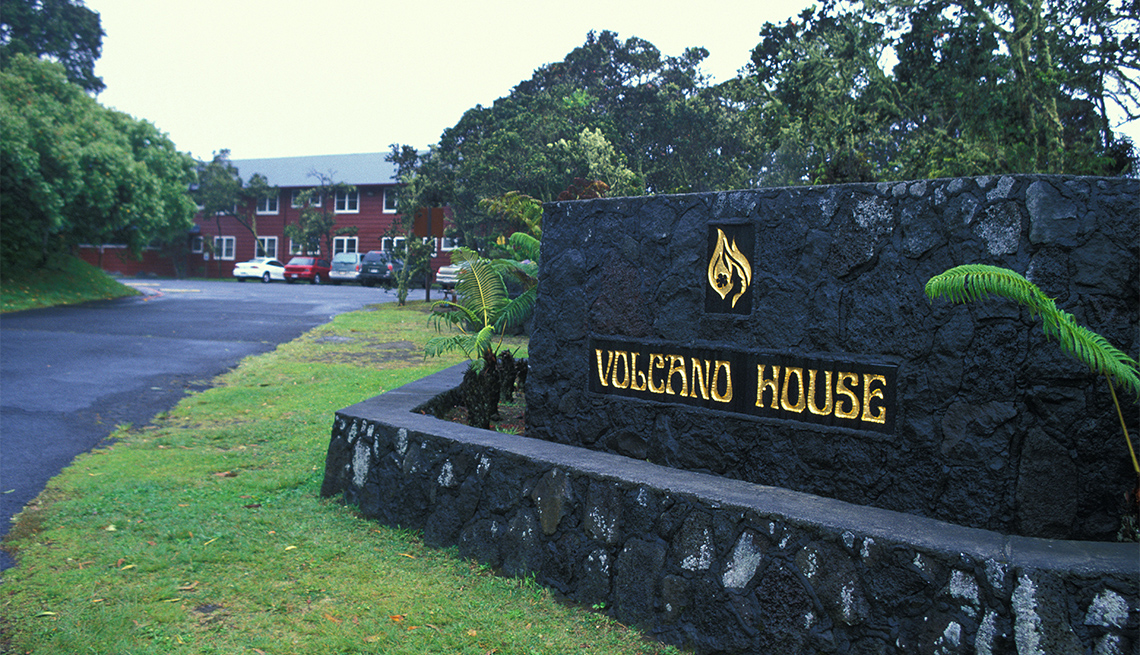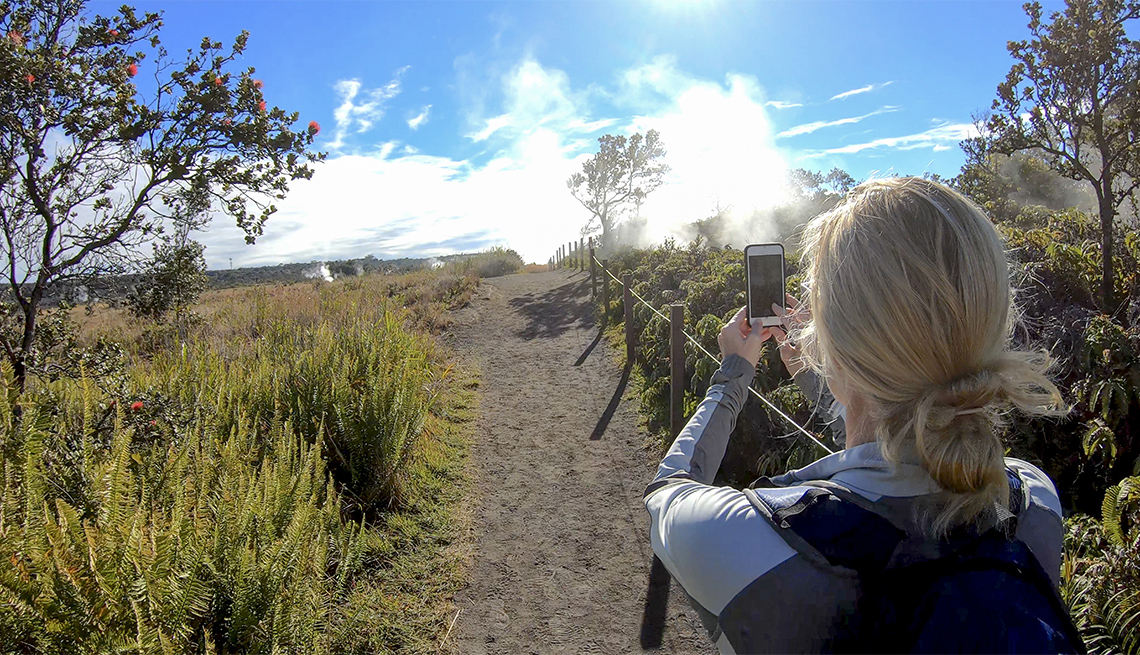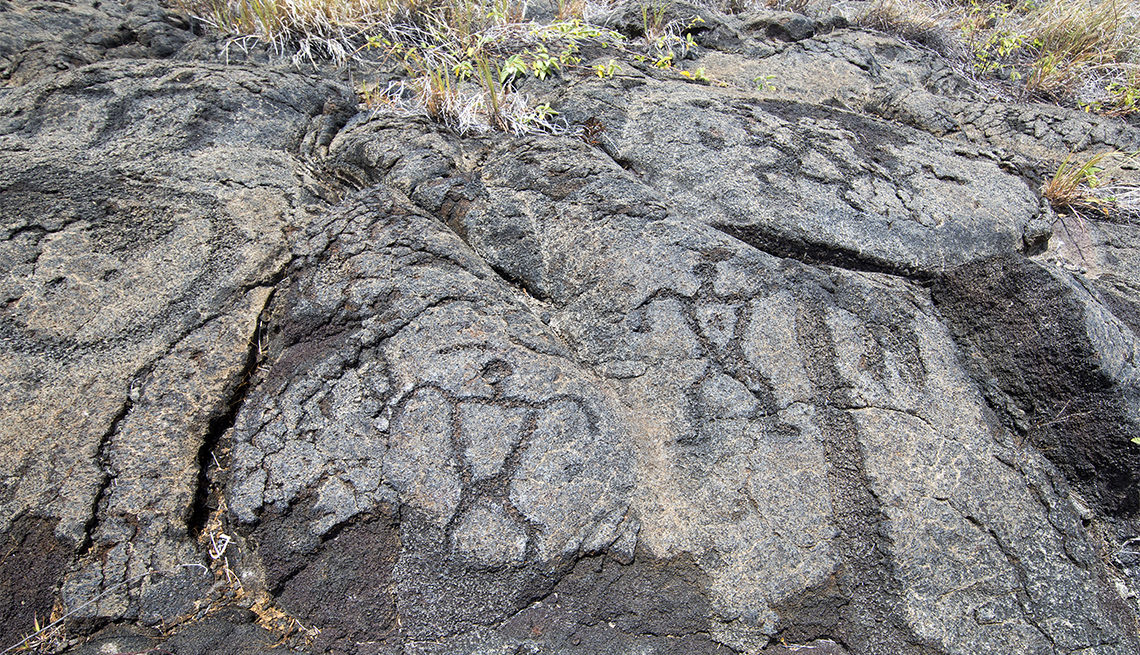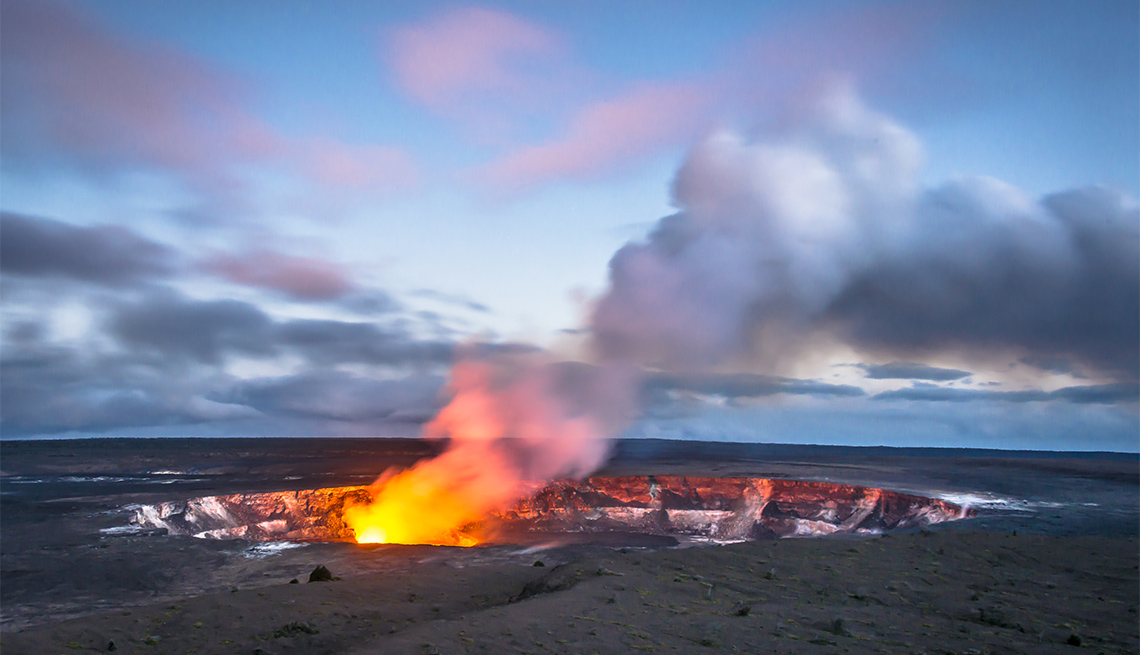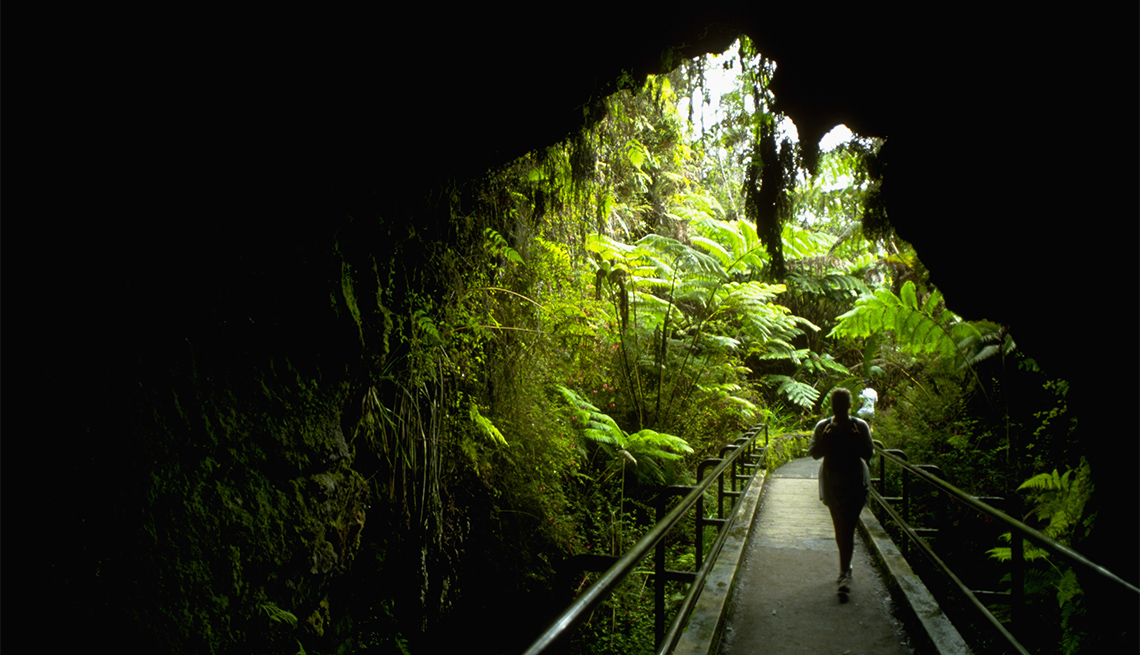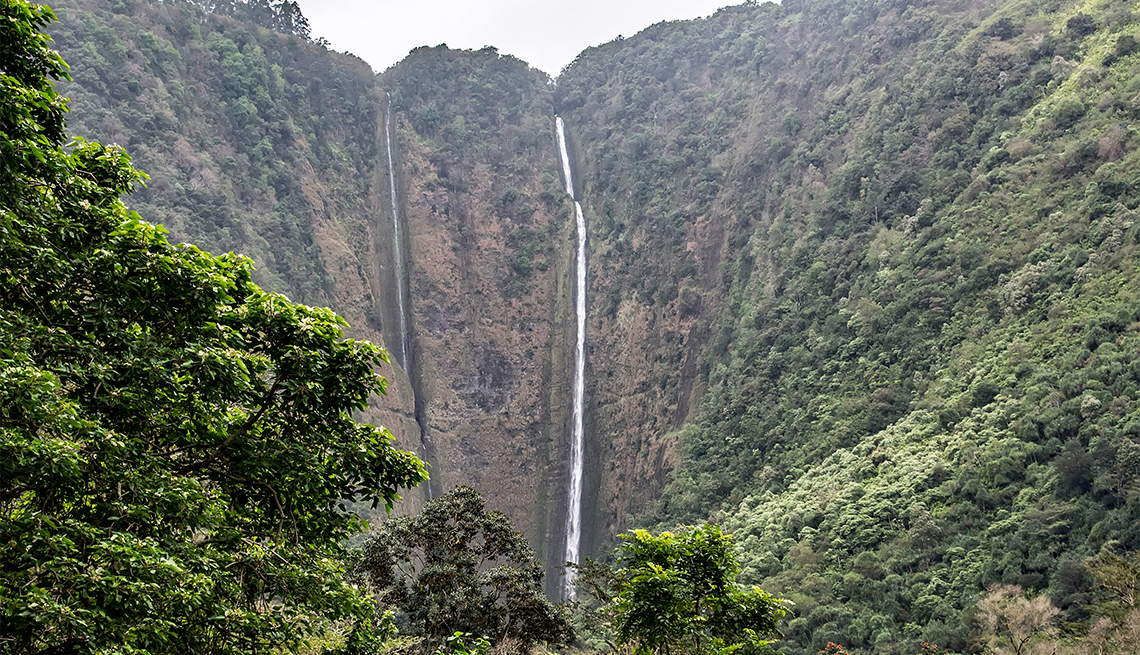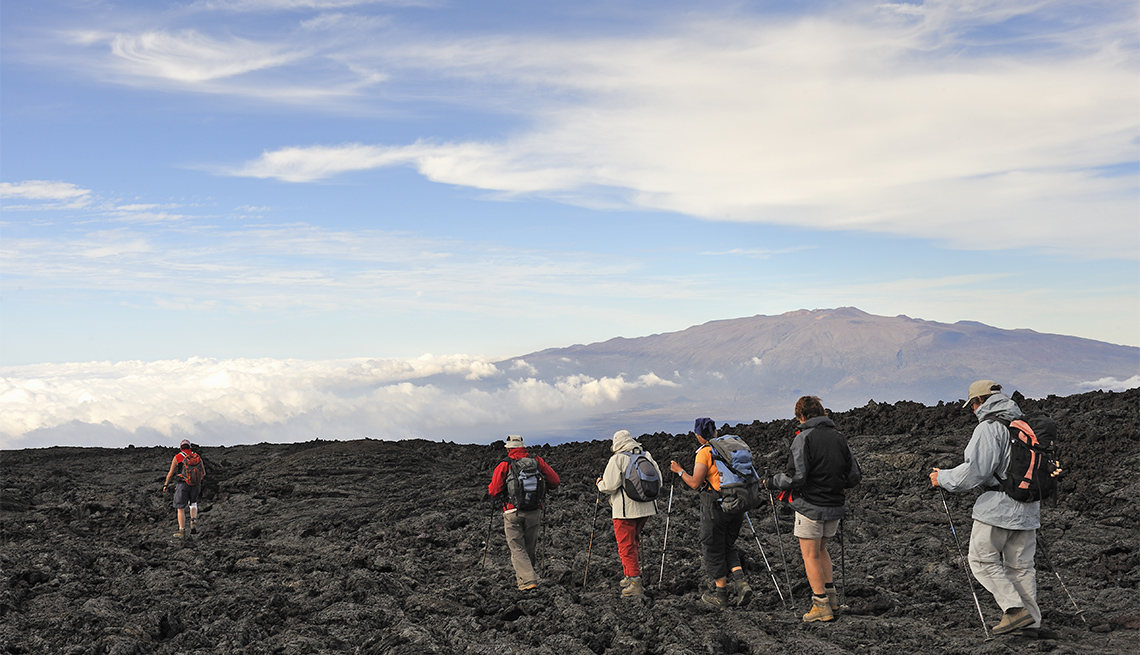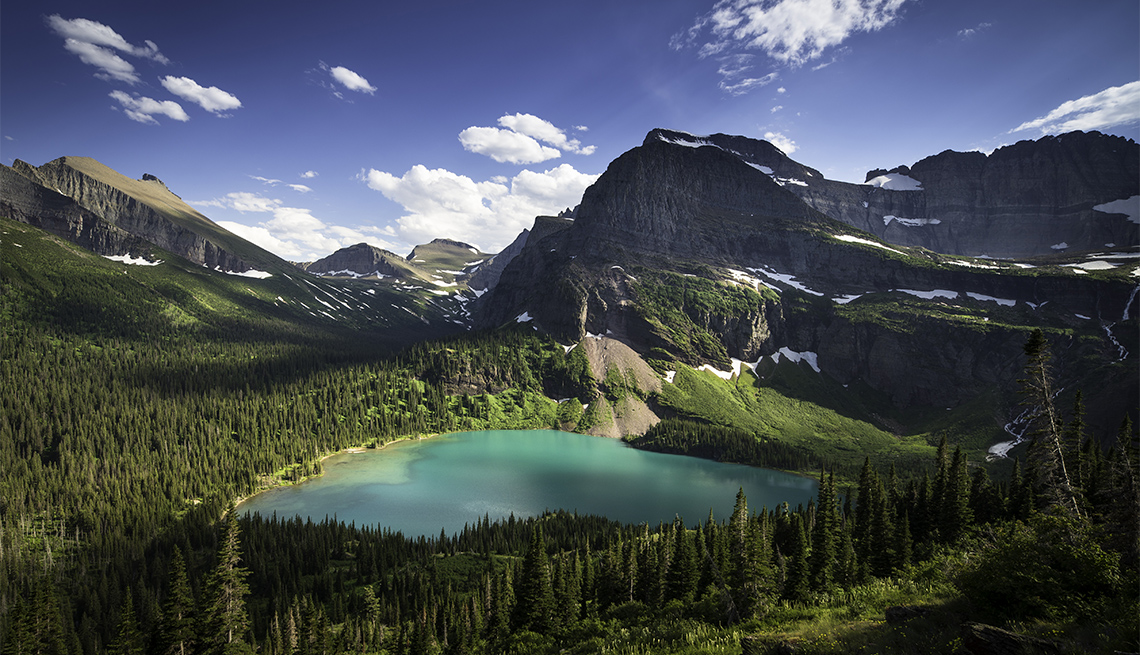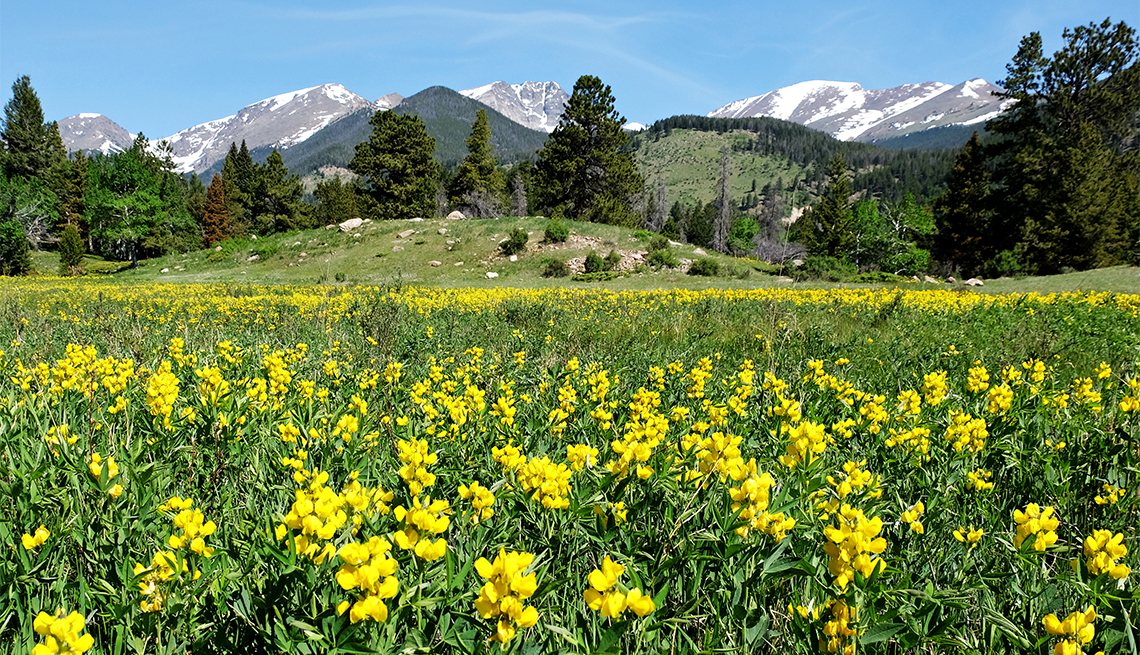AARP's Guide to Hawaii Volcanoes National Park
A nature lover's paradise of lava fields and lush rain forests
En español | Hawaii conjures images of swaying palms, sapphire seas, tranquil beaches and fragrant frangipani. So it can be a shock to arrive on the Island of Hawai'i, the archipelago's largest isle (the Big Island, it's often called) and confront the stark landscape where King Kamehameha the Great built his kingdom in the early 19th century.
The island's main attraction, Hawaii Volcanoes National Park (HVNP), feels otherworldly, with its primal lava fields, steam vents and wild, craggy coastline. But the park also offers extraordinarily varied terrain, with seven ecological zones — where its 1.4 million annual visitors can experience alpine tundra, barren desert, lush rain forests and more across its 335,259 acres.
Stretching from the sea to the 13,679-foot summit of Mauna Loa, HVNP was named a UNESCO World Heritage Site in 1987 for its rich biological, geological and cultural diversity.
That includes two of the world's most active volcanoes, Kilauea and Mauna Loa. According to native Hawaiian legend, the crater at Kilauea's summit is home to Pele, the Hawaiian goddess of fire. Her anger and jealousy are believed to trigger the eruptions that have long altered the island's landscape.
While Mauna Loa hasn't erupted since 1984, Kilauea had been spewing 2,000-degree molten lava continuously from 1983 until its historic eruption in 2018. The destruction caused by the eruption closed the park for more than four months — the longest shutdown in its history — but it also gifted the island a new black-sand beach at Isaac Kepoʻokalani Hale Beach Park.
Although the magma solidified into stretches of ebony igneous rock after the eruption, another lava lake formed in the summit crater in December 2020. While the public isn't allowed to get close enough to see it, you can view its reflective glow from many points along the caldera rim after dark, assures park spokesperson Jessica Ferracane. How long this latest eruptive activity will last is anyone's guess.
With or without an eruption, there is more to see in this park, which teems with wildlife, including 47 endangered species (such as the honu‘ea, or hawksbill turtle). Crater Rim Drive, a 10.6-mile road that circles the Kilauea Caldera, takes in all of the park’s main attractions, and there are 155 miles of trails to explore on foot.
Location: Island of Hawai'i's southeastern shore
Acreage: 335,259
Highest point: Summit of Mauna Loa, at 13,679 feet
Miles of trails: 155 miles of marked trails
Main attractions: Kilauea and Mauna Loa, two of the world's most active volcanoes
Cost: $30 per vehicle entrance fee ($20 with the annual Seniors Pass), valid for seven consecutive days
Best way to see it: By car on Crater Rim Drive, a 10.6-mile drive that takes in all of the park's main attractions
When to go to miss the crowds: Spring, though avoid the week in April when the Merrie Monarch Festival takes place
Cost: $30 per vehicle entrance fee ($20 with the annual Seniors Pass), valid for seven consecutive days. The park now offers digital entry passes, which can be purchased in advance at recreation.gov.
Plan Your Trip
Many visitors fly into Kona International Airport on the island's west side because of its proximity to the luxury resorts and famed beaches along the Kona-Kohala Coast. Later, when they're ready to visit HVNP, they make the 90-mile, two-hour drive south. If you're coming specifically to visit the park, Hilo International Airport is just 30 miles to the northeast, and an easy, 40-minute drive along Highway 11 to its entrance. The town of Hilo is a popular base, but for those who want to be at the park's doorstep, the town of Volcano, commonly called Volcano Village, is just five minutes from the entrance.
Unlike in your typical national park, you'll often be hiking on lava rock, not dirt trails. You'll need sturdy hiking boots and long pants; lava rock is as sharp as glass, and a fall will leave you with more than a scraped knee. Despite the precarious terrain, several trails are wheelchair-friendly, including the Sulphur Banks and Devastation trails; the latter leads through the reddish cinder outfall of the 1959 eruption of Kilauea Iki.
You'll also want to be prepared for all kinds of weather. The park can get more than 200 inches of rain a year, and with an elevation of 4,000 feet above sea level, temperatures can drop into the 40s. The summit occasionally gets snow throughout the year.
There are wheelchair-accessible restrooms or vault toilets at the Kīpukapuaulu picnic area; the Kilauea Visitor Center; the volcanic cone Mauna Ulu, which famously erupted from 1969 to 1974; the Volcano House hotel; and the turnaround at the end of Chain of Craters Road.
Located less than a quarter-mile from the entrance, the Kilauea Visitor Center is open from 9 a.m. to 5 p.m. daily and should be your first stop on a visit. Rangers and volunteers provide visitors with hiking information and the schedule of ranger-led activities.
HVNP doesn't offer public Wi-Fi access, though most of the park has good cellular reception, with the exception of the backcountry and parts of Chain of Craters Road, depending on your carrier.
Where to Stay and Eat
Set on the rim of the Kilauea Caldera, within walking distance of the Kilauea Visitor Center, the Volcano House is HVNP's sole hotel. The property opened in 1846 and past guests have included the likes of Franklin D. Roosevelt and Mark Twain. Of course, its 33 rooms (one ADA accessible) have been restored since then, and they now feature such retro island touches as tropical bedding and rattan furnishings.
By Hawai'i resort standards, the hotel can feel modest — don't expect TVs or minibars. You're paying for the location and amenities that aren't found elsewhere in the park, including reliable Wi-Fi. You'll also find the park's only restaurant, the Rim, which serves pub food with an island twist. Try the menu staple: the coconut-and-macadamia-nut-crusted fish-and-chips. Simple grab-n-go lunches (turkey sandwiches, taro chips and house-baked chocolate cookies) are a quick and affordable option if you prefer a picnic.
Sample the craft cocktails and Thai chicken wings at the hotel's Uncle George's Lounge. It hosts live music most nights, which draws a lot of customers, so advance reservations are a good idea.
The Volcano House also manages the Nāmakanipaio Campground, three miles west in a eucalyptus grove. It has 16 tent sites, 10 recently refurbished rustic cabins, plus amenities such as barbecues, fire rings, picnic tables, toilets and showers. Campers also get access to the hotel's amenities.
Though the Kulanaokuaiki Campground, nine miles south of the visitor center is a bit more rustic, it's especially good for stargazing. Its nine campsites have tent pads, picnic tables and a toilet, but no running water.
Reserve hotel accommodations at least one month ahead. The Nāmakanipaio Campground's cabins should be booked two months in advance, its campsites, a week in advance during peak season (June through August). Make all reservations through Volcano House. Kulanaokuaiki Campground is first-come, first-served. (For backcountry permits, contact Greg Santos at 808-985-6178.)
You'll find about a half-dozen picnic tables outside of the visitor center, a covered picnic table and pavilion at the Kilauea Overlook, picnic tables throughout Kulanaokuaiki Campground, and a wheelchair-accessible picnic area with a barbecue at Kīpukapuaulu, at the top of Mauna Loa Road.
Just outside of the park's main entrance, in Volcano Village, you can choose from a variety of hotels and restaurants. For the most upscale lodging, book the Volcano Rainforest Retreat, which features four handcrafted wooden cottages nestled under a canopy of giant ferns and native ‘ōhi'a trees.
There's also a 1930s YMCA camp-turned-hotel, Kilauea Lodge, with 12 on-site rooms and four off-site cottages. You'll want to work up an appetite on the trails so you can splurge on dinner at the lodge's restaurant. Four-course dinner menus include dishes such as pork belly with blueberry-rhubarb sauce and local citrus meringue tart. Volcano Village also features a 24-hour general store good for stocking up on picnic supplies.
Things to Do
Hike. HVNP is a hiker's paradise, with more than 150 miles of marked trails that traverse ecosystems from lush native rain forest to barren lava fields. The park offers many easy and relatively short day hikes that are ideal for people who have physical limitations but who still want to get out of the car to see the sights. The several wheelchair-friendly trails include the paved path that leads from the Kilauea Visitor Center to the Volcano House rim. NPS volunteer Eric Fandrick, who uses a wheelchair, also recommends the 1-mile round-trip Devastation Trail, a paved path that leads to the Pu'u Pua'i Overlook for a view into the Kilauea Iki Crater. “There's a section with a bit of a grade,” he says, “and some may require an extra push by a loved one, or appreciate the arm workout.”
Fandrick also suggests taking the Sulphur Banks Trail from the visitor center to the Steaming Bluff/Steam Vents area on Kilauea's rim. The 0.7-mile trail (often called the “little Yellowstone") meanders through native forest, sulfur deposits and steam vents. (Due to volcanic gases, visitors with heart or respiratory problems should avoid Ha'akulamanu — the Sulphur Banks — area.) On a clear day you get excellent views of Mauna Loa.
For more of a challenge, tackle the 4-mile Kilauea Iki Trail, which reopened in its entirety in September 2019 after being damaged during the Kilauea eruption. You'll marvel at the ever-changing scenery, which starts in a forest of native ‘ōhi'a trees and Hawaiian ferns and ends in a lake of frozen lava.
Bike. This is one of the few places in the world where you can bike through lava fields. Cyclists pay a $15-per-person entry free (Bike Volcano offers full-day guided park tours; bikevolcano.com).
Watch for birds. If you're a serious birder, bring your binoculars to the park for possible sightings of endemic birds, including the elepaio (monarch flycatcher), iiwi (scarlet honeycreeper) and nēnē. And do hike the Kipukapualulu Trail, a 1.2-mile loop often called “bird park” because hikers see so many forest birds on it.
See petroglyphs. The park's natural attractions often steal the spotlight, but HVNP's cultural richness, most notably the Pu'u Loa petroglyphs, adds to its appeal. Hawai'i's largest petroglyph field boasts more than 23,000 images as well as a sacred cultural site dating from between 1200 and 1450 A.D. You can access Pu'u Loa from a pullout parking area at milepost 16.5 along Chain of Craters Road. It's a 0.7-mile walk over a lava bedrock trail to reach Pu'u Loa's boardwalk, which winds above the stone artwork. Ranger-led tours provide a deeper cultural overview of the area.
Drive. Both of the park's two main roads, Chain of Craters and Crater Rim Drive, offer spectacular vistas. The 19-mile Chain of Craters Road explores the park's coastal region, winding from Kilauea's summit at around 4,000 feet down to sea level, passing through older lava flows and delivering stunning coastline views. Several overlooks suitable for wheelchair visitors include Kealakomo and Muliwai o Pele. Take in sunrise at the Hōlei Sea Arch observation area, about 1,000 feet past the gate at the end of the road. Note: You won't find any food, water or fuel along the road, but Volcano Village has a 24-hour gas station where you can fuel up and buy snacks and drinks. You'll find vault-type toilets at the Mauna Ulu parking area at the end of the road.
Crater Rim Drive, a 10.6-mile drive that circles the KilaueaCaldera, takes in all of the park's main attractions, including Nāhuku, a 500-year-old lava tube, and the Puʻu Puaʻi and Kilauea Iki crater overlooks.
Stock up with water and snacks in advance, then begin your drive at Kilauea Overlook and work your way clockwise along the road. The walk out to Keanakāko'i Crater delivers sweeping views across the Halema'uma'u and Kilauea craters. You walk over the old Crater Rim Drive, which is paved but has holes and cracks from the summit collapse of 2018. It's one of the best places to see the damage and changes inflicted on the park by the 2018 eruption, but you'll also see how native trees such as ‘ōhi'a thrive in this environment.
Be a responsible visitor and don't take rocks from the park. If you want to make an offering to Pele, buy a lei made from ti leaf, not plastic.
Gateway Towns
You'll find a variety of lodging and dining options at Volcano Village, just five minutes east of HVNP's entrance, as well as the must-visit Volcano Art Center. In addition to its art gallery, the center offers hula performances, cultural workshops and free guided tours (every Monday from 9:30 to 10:30 a.m.) of the 4-acre Niaulani Rain Forest, where you'll see rare old-growth koa trees. After a hike in the park, head to Oheo Café for local craft beers and delicious wood-fired pizzas.
Hilo, set at the base of a crescent-shaped bay, lies 45 minutes north of HVNP. Despite its slower pace, it's lovingly known as Hawai'i's “biggest small town.” A commercial hub for the sugar industry in the 1800s, today's downtown is a vibrant center of art, museums and restaurants. Much of its action is along a six-block strip lined with heritage buildings. Rise early to visit Suisan, a classic fish market known for hawking the freshest poke. Then grab breakfast at Ken's House of Pancakes, a 24-hour diner famed for its guava pancakes.
Hilo has three main cultural attractions, all dedicated to the natural world. At the Smithsonian-affiliated Lyman Museum and Mission House, take in volcano exhibits, sea life models, and one of the country's top mineral and gem collections. Learn about the tsunamis that nearly devastated Hilo in 1946 and 1960 at the Pacific Tsunami Museum. And discover how ancient Polynesians navigated by the stars at the Imiloa Astronomy Center, a 40,000-square-foot, state-of-the-art planetarium complex. When it comes to the actual natural world, Wailuku River State Park is a top attraction, with its 80-foot Waianuenue (Rainbow Falls) and Peepee falls.
Call ahead for dinner reservations at Moon and Turtle, where Hilo-born chef-owner Mark Pomaski's tapas menu takes inspiration from the local farmers market.
The recently renovated, 388-room Grand Naniloa Hotel, now managed by DoubleTree by Hilton, is the most polished property among the bay's sprinkle of accommodations, with its nine-hole golf course and spacious outdoor pool and fitness center.
For a comfortable off-the-grid alternative a few miles outside of town, check into the Inn at Kulaniapia Falls, with 13 rooms and three Asian-inspired cabins spread across 22 acres on a cliff overlooking a 120-foot waterfall. The completely sustainable inn generates its power from solar panels and a hydroelectric system powered by the falls. Nice perks: speedy Wi-Fi and an on-site farm that makes food a highlight. Guests can book cooking classes and private chef dinners. As the park's main gateway, Hilo fills up with visitors, so book hotel accommodations in advance. It can be particularly hard to find lodging during Merrie Monarch, a weeklong cultural festival that takes place each April.
AARP Membership -Join AARP for just $12 for your first year when you enroll in automatic renewal
Join today and save 25% off the standard annual rate. Get instant access to discounts, programs, services, and the information you need to benefit every area of your life.
En Route
If you make the Kona-Kohala Coast your base, the most direct route to the park is the two-hour drive south on Highway 11, but it's worth taking an extra 30 minutes to an hour to drive through the towns of Waimea and Hilo via highways 19 and 11.
Get a taste of the island's paniolo (Hawaiian cowboy) culture in Waimea. A rodeo arena lies just south of town, and a red-barn theme extends to the galleries and boutiques. The Gallery of Great Things feels like a cabinet of curiosities filled with both art and indigenous artifacts, such as woven baskets, opihi (limpet) shell necklaces and kapa, a fabric made by native Hawaiians. Don't miss the burgers at Village Burger, where the chef personally grinds and hand-shapes each pasture-raised Hawaiian beef patty.
From Waimea, it's a 30-minute drive along Route 19 and Kukuihaele Road to reach the Waipio Valley Lookout. Cut deeply into Kohala mountain, the valley is about a mile wide and six miles long, stretching from the black-sand bay at its mouth between sheer, 2,000-foot cliffs. Its nickname, Valley of Kings, is a nod to the fact that this was once the ancient capital of the island and the home of many early Hawaiian chiefs now buried in caves along the valley's steep rock walls. Its main draw today is its waterfalls, most notably Hi'ilawe Falls. One of the state's tallest falls at 1,450 feet, it's best viewed by from the air on tours offered by outfitters such as Blue Hawaiian Helicopters.
For more waterfall action, head another hour east on Highway 19 to ‘Akaka State Park, where a 0.4-mile hike along the mellow ʻAkaka Falls Loop Trail brings you to the 422-foot cascade. Travel another 25 minutes east along 19 to detour at Liliuokalani Gardens. Named after Hawaii's last reigning monarch, the free park boasts the largest ornamental Japanese garden outside of Japan and has stellar views of Hilo Bay.
- |
- Photos
Freelance writer and editor Jen Murphy contributes to a variety of publications, including Condé Nast Traveler, Outside, Travel + Leisure and The Wall Street Journal.
Editor's note: This article was originally published on April 13, 2021. It's been updated to reflect new information.

